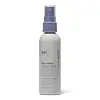What's inside
What's inside
 Key Ingredients
Key Ingredients

No key ingredients
 Benefits
Benefits

 Concerns
Concerns

 Ingredients Side-by-side
Ingredients Side-by-side

Water
Skin ConditioningGlycerin
HumectantPolyglyceryl-10 Laurate
Skin ConditioningPolyglyceryl-4 Caprate
EmulsifyingPhenoxyethanol
PreservativePolyglyceryl-4 Laurate
EmulsifyingSodium Citrate
BufferingCaprylyl/Capryl Glucoside
CleansingDisodium EDTA
Arginine
MaskingParfum
MaskingCetrimonium Chloride
AntimicrobialPropylene Glycol
HumectantCitric Acid
BufferingEthylhexylglycerin
Skin ConditioningAdansonia Digitata Seed Oil
EmollientChenopodium Quinoa Seed Extract
Skin ConditioningButylene Glycol
HumectantHydrolyzed Vegetable Protein
Skin Conditioning1,2-Hexanediol
Skin ConditioningHydrolyzed Soy Protein
HumectantHydrolyzed Wheat Protein
Skin ConditioningHydrolyzed Corn Protein
Skin ConditioningSapindus Mukorossi Fruit Extract
Skin ConditioningAloe Barbadensis Leaf Extract
EmollientSodium Hyaluronate
HumectantCeramide NP
Skin ConditioningHydrogenated Lecithin
EmulsifyingSodium Benzoate
MaskingStearic Acid
CleansingSucrose Stearate
EmollientSphingolipids
EmollientCholesterol
EmollientWater, Glycerin, Polyglyceryl-10 Laurate, Polyglyceryl-4 Caprate, Phenoxyethanol, Polyglyceryl-4 Laurate, Sodium Citrate, Caprylyl/Capryl Glucoside, Disodium EDTA, Arginine, Parfum, Cetrimonium Chloride, Propylene Glycol, Citric Acid, Ethylhexylglycerin, Adansonia Digitata Seed Oil, Chenopodium Quinoa Seed Extract, Butylene Glycol, Hydrolyzed Vegetable Protein, 1,2-Hexanediol, Hydrolyzed Soy Protein, Hydrolyzed Wheat Protein, Hydrolyzed Corn Protein, Sapindus Mukorossi Fruit Extract, Aloe Barbadensis Leaf Extract, Sodium Hyaluronate, Ceramide NP, Hydrogenated Lecithin, Sodium Benzoate, Stearic Acid, Sucrose Stearate, Sphingolipids, Cholesterol
Water
Skin ConditioningPropylene Glycol
HumectantPEG-40 Hydrogenated Castor Oil
EmulsifyingPhenoxyethanol
PreservativeCetrimonium Chloride
AntimicrobialStearyl Dihydroxypropyldimonium Oligosaccharides
Parfum
MaskingQuaternium-80
Ethylhexylglycerin
Skin ConditioningMacadamia Ternifolia Seed Oil
EmollientStyrene/Vp Copolymer
Hydrolyzed Corn Protein
Skin ConditioningHydrolyzed Soy Protein
HumectantHydrolyzed Wheat Protein
Skin ConditioningButylene Glycol
HumectantHelianthus Annuus Seed
Skin ConditioningPhosphoric Acid
BufferingCitrus Limon Fruit Extract
MaskingAnanas Sativus Fruit Extract
Skin ConditioningPassiflora Edulis Fruit Extract
Skin ConditioningVitis Vinifera Fruit Extract
Skin ConditioningAlcohol Denat.
AntimicrobialSorbic Acid
PreservativeWater, Propylene Glycol, PEG-40 Hydrogenated Castor Oil, Phenoxyethanol, Cetrimonium Chloride, Stearyl Dihydroxypropyldimonium Oligosaccharides, Parfum, Quaternium-80, Ethylhexylglycerin, Macadamia Ternifolia Seed Oil, Styrene/Vp Copolymer, Hydrolyzed Corn Protein, Hydrolyzed Soy Protein, Hydrolyzed Wheat Protein, Butylene Glycol, Helianthus Annuus Seed, Phosphoric Acid, Citrus Limon Fruit Extract, Ananas Sativus Fruit Extract, Passiflora Edulis Fruit Extract, Vitis Vinifera Fruit Extract, Alcohol Denat., Sorbic Acid
Ingredients Explained
These ingredients are found in both products.
Ingredients higher up in an ingredient list are typically present in a larger amount.
Butylene Glycol (or BG) is used within cosmetic products for a few different reasons:
Overall, Butylene Glycol is a safe and well-rounded ingredient that works well with other ingredients.
Though this ingredient works well with most skin types, some people with sensitive skin may experience a reaction such as allergic rashes, closed comedones, or itchiness.
Learn more about Butylene GlycolThis ingredient is a preservative, antimicrobial, and emulsifier. It is often used in cosmetics for its ability to cleanse, condition, and reduce static.
Cetrimonium chloride is a quaternary ammonium salt, meaning it has a water-soluble structure.
Ethylhexylglycerin (we can't pronounce this either) is commonly used as a preservative and skin softener. It is derived from glyceryl.
You might see Ethylhexylglycerin often paired with other preservatives such as phenoxyethanol. Ethylhexylglycerin has been found to increase the effectiveness of these other preservatives.
We don't have a description for Hydrolyzed Corn Protein yet.
Hydrolyzed Soy Protein is a vegan protein made to mimic hydrolyzed collagen. It is created from soy, or glycine soja.
This ingredient is a humectant, meaning it helps hydrate the skin by binding to water. According to a manufacturer, it is also a great hair conditioner.
Read more about hydrolyzed collagen here.
Learn more about Hydrolyzed Soy ProteinWe don't have a description for Hydrolyzed Wheat Protein yet.
Parfum is a catch-all term for an ingredient or more that is used to give a scent to products.
Also called "fragrance", this ingredient can be a blend of hundreds of chemicals or plant oils. This means every product with "fragrance" or "parfum" in the ingredients list is a different mixture.
For instance, Habanolide is a proprietary trade name for a specific aroma chemical. When used as a fragrance ingredient in cosmetics, most aroma chemicals fall under the broad labeling category of “FRAGRANCE” or “PARFUM” according to EU and US regulations.
The term 'parfum' or 'fragrance' is not regulated in many countries. In many cases, it is up to the brand to define this term.
For instance, many brands choose to label themselves as "fragrance-free" because they are not using synthetic fragrances. However, their products may still contain ingredients such as essential oils that are considered a fragrance by INCI standards.
One example is Calendula flower extract. Calendula is an essential oil that still imparts a scent or 'fragrance'.
Depending on the blend, the ingredients in the mixture can cause allergies and sensitivities on the skin. Some ingredients that are known EU allergens include linalool and citronellol.
Parfum can also be used to mask or cover an unpleasant scent.
The bottom line is: not all fragrances/parfum/ingredients are created equally. If you are worried about fragrances, we recommend taking a closer look at an ingredient. And of course, we always recommend speaking with a professional.
Learn more about ParfumPhenoxyethanol is a preservative that has germicide, antimicrobial, and aromatic properties. Studies show that phenoxyethanol can prevent microbial growth. By itself, it has a scent that is similar to that of a rose.
It's often used in formulations along with Caprylyl Glycol to preserve the shelf life of products.
Propylene Glycol is an odorless, colorless liquid. As a humectant, it helps skin retain moisture. It also aids in delivering active ingredients.
Another role of this ingredient is preventing a product from melting or freezing. Propylene glycol also adds antimicrobrial properties to a product, elongating product lifespan.
This ingredient is considered an organic alcohol and commonly added into both cosmetics and foods.
Those with sensitive skin or conditions may develop a rash when using this ingredient.
Learn more about Propylene GlycolWater. It's the most common cosmetic ingredient of all. You'll usually see it at the top of ingredient lists, meaning that it makes up the largest part of the product.
So why is it so popular? Water most often acts as a solvent - this means that it helps dissolve other ingredients into the formulation.
You'll also recognize water as that liquid we all need to stay alive. If you see this, drink a glass of water. Stay hydrated!
Learn more about Water